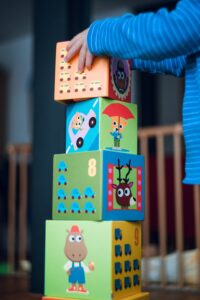Children crying, clutching to the legs of their parents, or squeezing their necks. Mommy and Daddy desperately trying to calm their kids at their childcare facility – all the while trying not to fall apart themselves. Teachers trying their very best to keep things orderly. Screaming and panic abounding.
How Do I Help My Child With Daycare Blues?
Does this scenario sound familiar? This can certainly be a chaotic event, but it can be a rather typical start to a day for many children. Sure, starting childcare or nursery school should be an exciting time and a happy occasion, but for many kids, their raw emotions may well turn into a case of back-to-school blues. Their panic-stricken faces indicate they are dealing with separation anxiety.
Anxiety is Normal
Our little ones aren’t the only ones in a panic. Childcare teachers and staff are also scrambling to offer comfort, to find the right thing to say or do – anything to distract the child and calm his fears. It can be difficult knowing how to handle the situation. Summit Children’s Center, childcare center in Lee’s Summit, would like to offer some ideas for helping to ease this stressful and emotional time.
First of all, you should know that separation anxiety is completely normal. In fact, anxiety is a very useful stage in a child’s development. Think about it. Even in prehistoric times, separation anxiety kept children close to their parents and other caretakers, resulting in a natural protected

Childcare Center Lees Summit
emotion and sense of security. Likewise, the anxiety of modern-day children also keeps them protected and safe. Children are born to fear a distance from the maternal and paternal. As parents, we are also conditioned to feel panic when our babies are at a distance or are being cared for by someone else. The trick is to understand when there is no real danger and to dismiss the unnecessary anxiety.
Now, of course, there can be very extreme cases of separation anxiety, when a child’s experience rises to detrimental levels of panic. If the level of a child’s anxiety disrupts relationships, results in real physical illness, or if the panic becomes debilitating and is not appropriate for their age, then a physician or child psychologist may want to examine the child and develop a plan of treatment.
But, for the majority of us, there is good news. Normal separation anxiety is quite common and manageable with planning and patience. Even better news, childcare centers like Summit Children’s Center, are here to help manage and lessen separation anxiety.
What Can I Do To Help My Children Adjust to Daycare?
There are good tips for helping you as well as your children in the childcare process. Seeing our kids sad and fearful can be upsetting, and it feels terrible as a parent to just walk away while they are wanting desperately to stay with you. What is completely instinctual, of course, is to rush back and provide the comfort they want. But, you have to focus on a plan for breaking the anxiety cycle – a plan which will help them become stronger and more independent. As a result, parent, child, and childcare center will all feel much better.
Establishing a Few Do’s and Dont’s for School
First, begin talking about the childcare experience even before it begins. Tell your child how exciting the childcare program is going to be. If it’s the very first day that is causing them to worry, begin encouraging them a week or two before, explaining all the fun they will have at school. Explain all the steps in the routine. You’ll drop them off at a certain time, and you’ll come back at a certain time. Try a calendar which counts down the days until the fun of daycare starts. If the preschool or childcare program has already begun, discuss each upcoming day at bedtime. Let your child help with the process of leaving the house.

Allow them to prepare their backpack, choose an outfit, decide on lunch. Do this all in advance and let them feel that they play an important part in the planning. The thing to remember here is; there should be no surprises. You won’t be alone in this process. Summit Children’s Center, Lee’s Summit childcare center, will help prepare the child along with you, the parent, on the new adventure!
Avoid giving your child any idea that there is something to worry about when starting daycare. If the child isn’t showing signs of distress, do everything you can to avoid introducing them. If they are looking forward to the experience at the new childcare center, don’t squelch it. If they are having a positive experience leading up to the day, there is no need to ask if they are worried, or to tell them they are “brave for going all alone.” This would be counter-productive.
Take a trip to the school before the day they are to begin. Let them see the location and, if possible, spend a few minutes in the environment. Look at the playground. Visit the lunch room. Meet the teacher. Use it as an advantage and help your child become familiar with things before the transition. “Here’s your very own cubby to store your coat,” or “Look, the bathroom is right down this hall.” All of this preparation will ease a child’s anxiety.
But try not to overdo it. Kids are intuitive and will know when you are being insincere. Maybe introduce your child to the new childcare teacher, but explain that the child should say goodbye without mom or dad holding their hand. Then make it a little game or a challenge. “Now show me which cubby is yours.” or “How many doors down to the bathroom?” You’re doing your part to teach your child a bit of independence. Later on, at home, remind them of these small victories.
Saying Goodbye Can Be Difficult
Plan out the goodbye routine, then stick with it. Make your plan in advance, before you arrive at the childcare center. Invent that one simple thing that will give them comfort all day. Perhaps, it is a kiss on the cheek or your secret fist bump. Let them know it’s special – just between the two of you. Whatever the routine, the important thing is to leave the new child care center (right away), after the routine is concluded. Your child may try and bait you into staying or coming back for “one more thing.” Don’t do it. Set the expectation, then do not vary it. Goodbye is final (at least for this day). “I’ll see you later when I come back to get you.”
Tell yourself again, don’t stay too long at the childcare center. The goodbye can’t be overstated. Sure, it hurts seeing your young child upset and afraid, and it’s painful. However, kids are smart, and if you rush back or linger, they’ll learn that they have the leverage to manipulate you, and they’ll use it. Yes, their tears are real, but they’re normal.
Keep control of your emotions and project a sense of calm at the new childcare program, just as you would with your child on a normal day at home. Your heart may be breaking, but be strong. Keep it together. If you display anguish, it’s only going to make it worse for your child. Be brave and show your child that everything is fine and they will get through this. You are doing this to help them feel more secure, more independent. They want to stay with you when you’re crying, in the same way, you want to be there for them when they are crying.
Never try and sneak away when they aren’t looking. You might be tempted. “She’s not crying at this very moment and she has turned her back. I’ll just make my getaway now.” This might seem sensible in that stressful and frantic moment, but it’s not. Avoid anything that appears to them like you’re breaking a trust. Avoiding the panic now will not help them build self-resilience for later.
Emotions are valid and you must help your child understand that. A little anxiety is okay. Reassure your child that it is natural. Explain how fear helps them to stay safe when there is a real danger. “But you’re safe with your teacher at Summit Children’s Center, just as you are with mom and dad at home.” Then the most important thing: “I know you’re worried, but I promise that I’ll be back to get you later. Honest, I’ll be back.”
Avoid rewards, threats or consequences. “Please stop crying and I promise to buy you candy later,” or “Stop crying or we won’t play baseball tonight.” Separation anxiety is an emotion, not a behavior. Therefore, behavior manipulation won’t work in these cases.
Simple and Straight Foward Language is Important

Summit Children’s Center recommends using words similar to this, “Okay, let’s just breathe for a minute. You’re afraid and I understand. Mommy loves you and I wouldn’t let anything scare you. Remember, we talked about this at home. It’s called anxiety.
Take a look at your classroom. Is there anything in here to be afraid of? Do you see anything dangerous? I can see your teacher. You’ve met her before. She’s a very nice lady. The other kids are having fun and they want you to be happy like them. Okay, let’s take another breath together, then we can do our secret fist bump, and then mommy will come back to this exact spot when the childcare program is over.”
When choosing the childcare center for you and your child, remember Summit Children’s Center is here to help with the process and is the perfect place to begin this next chapter. Contact us for a visit today!





